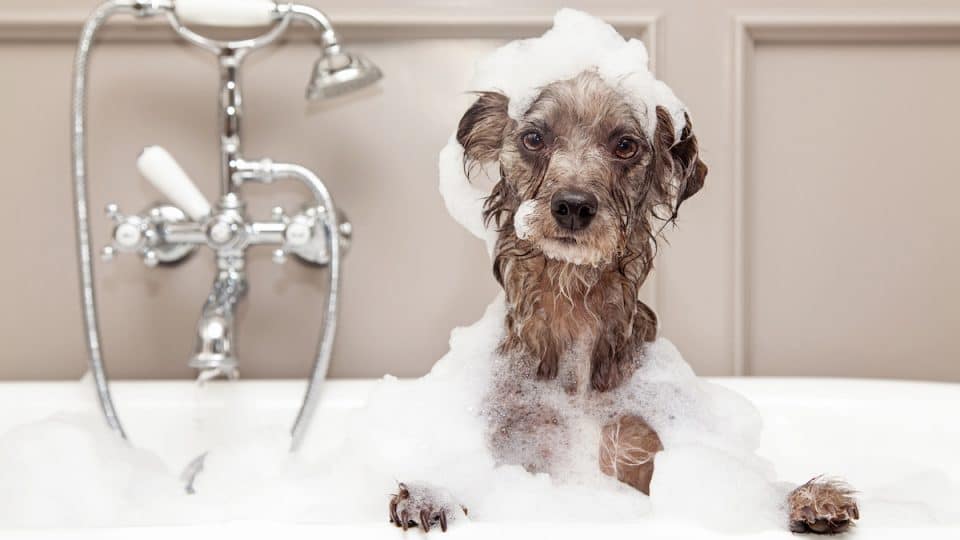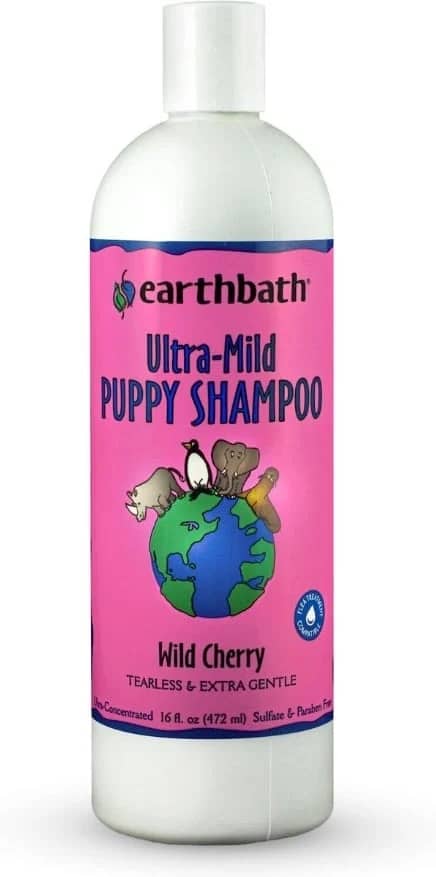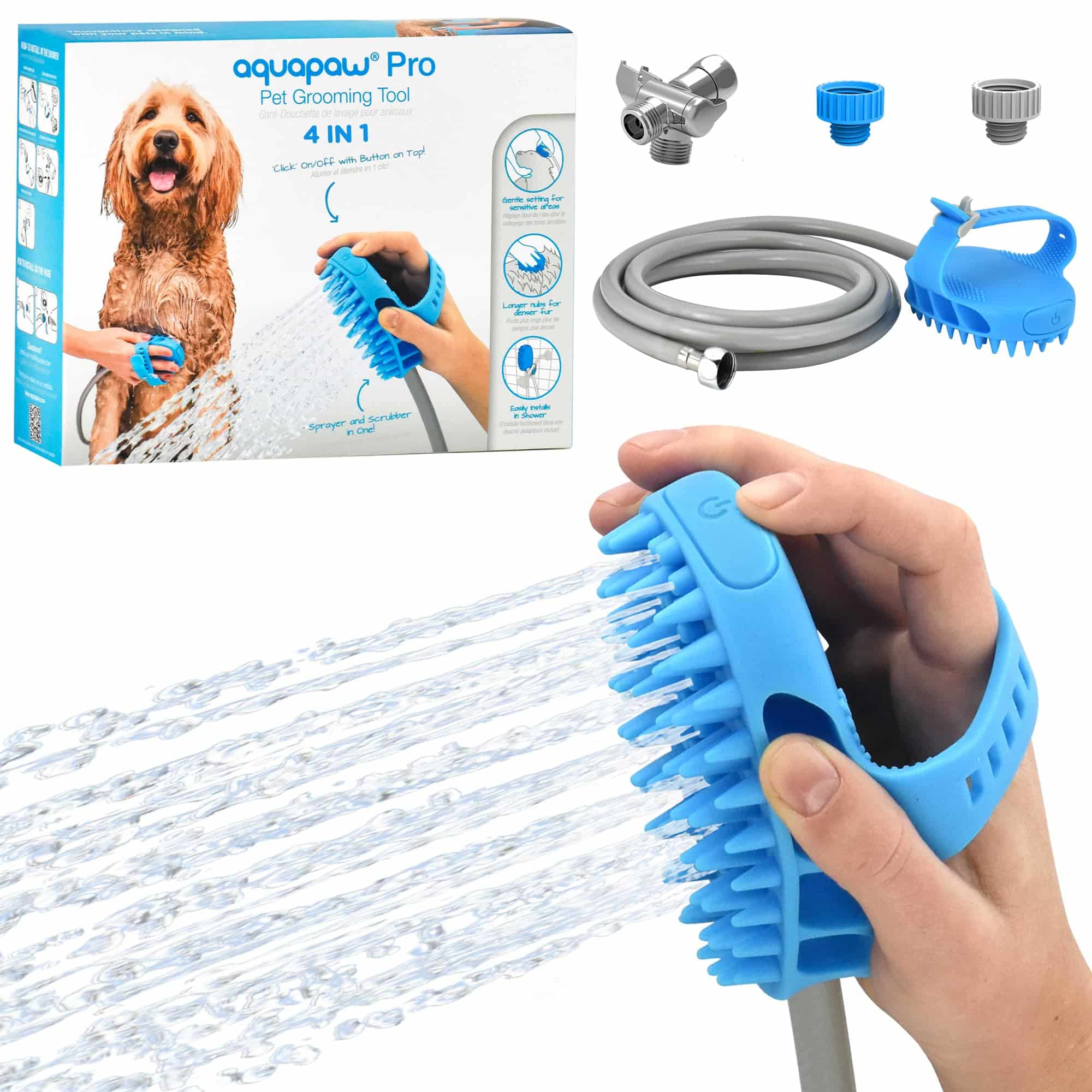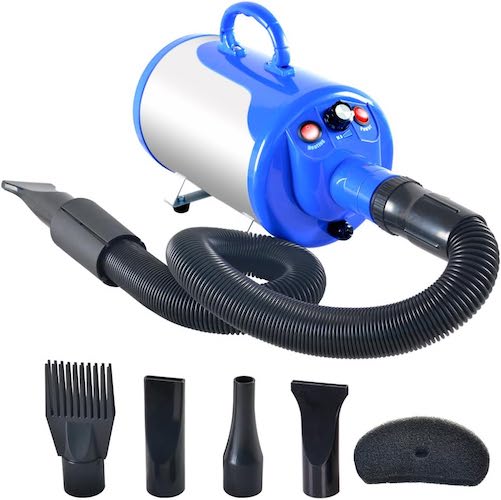- This review contains affiliate links. Read more here.
- Not a substitute for professional veterinary help.
Bathing a full-grown dog is one thing, but trying to bathe a squirmy, energetic puppy is a whole other challenge. When and how do you even start?
For the first few months of your puppy’s life, you only need a soft cloth and some warm water to clean your new friend. But once your puppy reaches 8 weeks old, they’ll be ready for a full-fledged bath with puppy shampoo.
For expert tips on how to bathe a puppy, we reached out to Kim Kier, owner and fear-free certified groomer at Little Barks Grooming. With her insight, we share how often to give a puppy a bath, what you can do to make bathtime stress-free, and when you should go to the groomer instead. We also share our top picks for dog shampoos and other grooming products. Suds away!
How Often To Bathe a Puppy
For puppies, a bathtime cadence of every three to four weeks should keep them clean without causing skin irritation. However, if your new friend gets especially muddy, it’s okay to bathe them more frequently. “Regular baths help with socialization, cleanliness, and maintaining healthy skin and coats—especially if your puppy is prone to skin conditions,” says Kier.
Your puppy’s fur type will also impact how often you bathe them. For instance, dogs with oily coats, like hounds, will need to be bathed more often than pups with water-repellant coats, like Golden Retrievers and Labs.
Introducing your puppy to baths at an early age and keeping a regular bathing schedule can make handling and grooming much easier as your pup gets older. “Getting your puppy used to baths early on lays the foundation for a lifetime of positive grooming experiences. Puppies are naturally curious, and early exposure to bathing helps reduce anxiety and fear later on,” she says.
Step By Step Instructions
Ready to give your puppy their first bath? Here are some bathtime tips and simple steps to follow.
Step 1. Purchase the right products
Choose a dog shampoo made specifically for puppies and their sensitive skin. The best puppy shampoos and conditioners will be free of harsh chemicals. They’ll also have gentle and hydrating ingredients, like colloidal oatmeal and aloe vera.
Step 2. Choose tub vs. sink vs. shower
How big your puppy is will help you decide the best bath spot in your home. For small puppies, the sink might be the most convenient option, while larger pups may be more comfortable in a tub or shower.
If you’re especially crafty, building a separate doggy shower station can create a more comfortable bathing experience for everyone involved.
Step 3. Find the right water temperature (plus how to test it)
The best bath temperature for a puppy should be around 99 to 100 degrees, which is close to a pup’s body temperature. “Lukewarm water is best—too hot or too cold can cause discomfort,” confirms Krier.
To test the temperature, dip your hand in the water (or use a bath thermometer if you want to be exact). The right temperature should feel pleasantly warm but not hot.
Puppies can easily overheat or get cold quickly, so check the temperature often to ensure your puppy is comfortable.
Step 4. Get your puppy wet
Introduce the water to your puppy slowly and gently. Use a handheld sprayer or a rinse cup, starting at the back of the body. Gently wet your pup while avoiding their face and ears.
A dog shower attachment can make wetting and rinsing your dog a lot easier, too.
Step 5. Massage in the shampoo
The best way to work shampoo into your dog’s coat is to gently massage it into their fur. A rubber dog brush can work well here, helping to remove loose fur and dirt. Plus, your pup might enjoy the extra spa treatment!
Kier advises moving slowly and praising your pup along the way to help create a positive association with being handled throughout the bathing process.
Step 6. Rinse thoroughly
Use lukewarm water to rinse your pup thoroughly with a handheld sprayer, shower attachment, or bucket. Take special care to avoid your pup’s face and ears.
Step 7. Dry completely
Drying your pup thoroughly after bathing them can help prevent mats, tangles, and skin infections from damp fur.
“After the bath, gently pat them dry with a towel and let them air dry, or use a hair dryer on the lowest, coolest setting if your puppy is comfortable with that,” says Kier.
Dos and Don’ts
Here are some expert tips to help make bathtime as pleasant as possible.
Do keep bathtime short
Keep baths short and sweet. Gather your shampoo and puppy treats ahead of time so they’re on hand and ready. Running the bath water ahead of time can also cut back on the time your pup spends in the tub.
Do use treats
Kier encourages using positive reinforcement, like treats and praise, to help make the experience as enjoyable as possible. Attaching a lick mat with a tasty spreadable treat to the side of the tub also offers an excellent distraction.
Do make bathing a game
Puppies love silly fun, so why not make your bath time a puppy game too? Invest in a few waterproof toys just for bath time so your pup has something to look forward to. Or hide treats in cups along the side of the tub for them to knock over and sniff out. The goal here is to make baths = fun!
Do start slow
“Bath time can be stressful for puppies. Take your time, avoid rushing, and speak in a soothing voice to keep your puppy at ease,” says Kier.
Pro tip: Familiarize your pup with the tools you’ll be using during bathtime ahead of schedule. For instance, let them smell the shampoo bottle. Or turn on the blow dryer in short bursts, praising and showering them with treats each time it’s on.
Don’t leave any soap on your dog
Make sure to rinse your puppy thoroughly. Leaving soap residue can cause skin irritation or make your pup feel itchy.
You’ll know your puppy’s coat is suds-free when the water runs clear. If you’re not sure, rinse again (and again). Your pup’s not fully clean until they’ve been properly rinsed off.
Going to the Groomers
Around the 10- or 12-week mark, after your puppy has completed their full vaccination schedule, you can take them to the salon for professional grooming. This is an especially good idea for puppies who are difficult to bathe at home or have special coats that require careful grooming. (Hello, Poodles!)
In addition to bathing and haircuts, pet parents can also request other services at the groomers, like teeth brushing, ear cleaning, nail trimming, and expressing anal glands.
Our Top Picks/Product Recommendations
We’ve rounded up some of our favorite product picks for puppy bathtime, including various shampoos and grooming tools.
Our top pick for puppy shampoos is this gentle formula from Earthbath. Featuring a coconut-based cleanser, this shampoo is pH-balanced and tear-free. It also has aloe vera and vitamin E for sensitive skin and a mild cherry fragrance for a fresh, clean scent.
A puppy-safe shampoo with conditioner can help moisturize dry skin and fur that’s in need of some extra TLC. Suitable for pups 8 weeks and older, this Pro Pet Works two-in-one formula has oatmeal, almond oil, and aloe vera to soothe itchy and sensitive skin. It also works great as a detangler if your pup’s wily coat needs some extra help.

Pro Pet Works Organic Oatmeal Pet Shampoo and Conditioner
This shampoo and conditioner is formulated for pups with sensitive and dry skin.
Extras like a rubber brush and shower attachment can go a long way in getting your puppy squeaky clean. Now you can have both in one! This Aquapaw Pro Grooming tool features a showerhead that serves double duty as a bath brush, which impressed our product testers.
If your pup has short hair or gets cold easily, wrap them in a cozy and snuggly bathrobe towel for extra warmth. This doggy robe by Geyecete comes in smaller sizes and has elastic straps to securely fit your puppy.
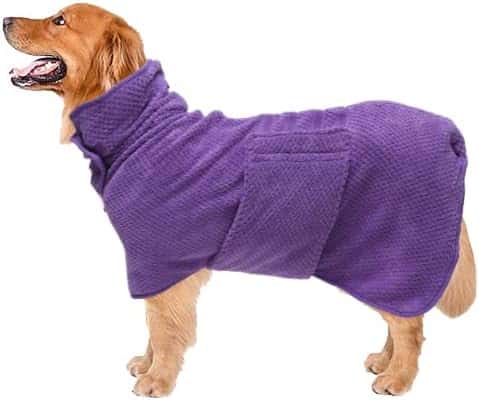
Geyecete Dog Bathrobe Towel
Keep your puppy cozy and dry with this machine-washable bathrobe towel.
A dog blow dryer can speed up the drying process for impatient young pups. This Shelandy Pet Hair Dryer is excellent for pet parents and pups new to grooming, with its quiet sound and multiple speed settings. It also offers a decent price (under $100) for those still testing whether or not their puppy is a good candidate for blow drying. Our blow-dryer testers gave it four paws up.
Benefits of Bathing Your Puppy Early & Often
Giving your puppy regular baths doesn’t just keep them clean, it also helps set them up for a lifetime of healthy and happy handling.
“The sensitive socialization period for puppies is from 3 weeks to 3 months, making it important to expose them to new experiences. During this time, they’re most susceptible to bonding with people and learning that environments are safe and welcoming,” explains Kier. “The more we expose them to grooming in a positive manner, the more likely it will become a fun, comfortable, and routine activity that they look forward to for a lifetime.”
